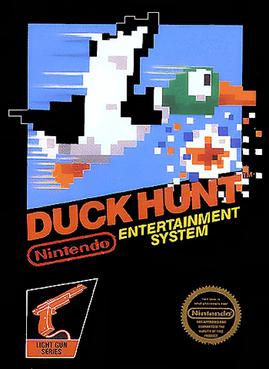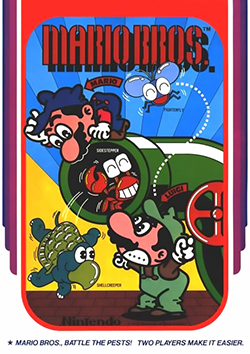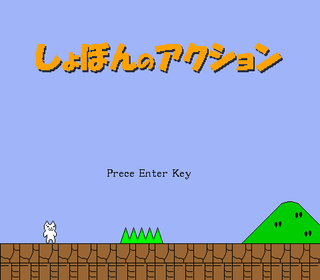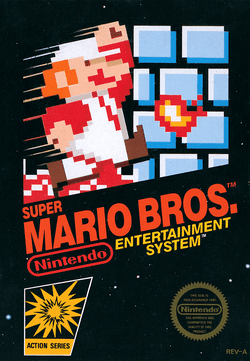
Duck Hunt is a 1984 light gun shooter video game developed and published by Nintendo for the Nintendo Entertainment System (NES) video game console and the Nintendo Vs. System arcade hardware. The game was first released in April 1984, in Japan for the Family Computer (Famicom) console and in North America as an arcade game. It became a launch game for the NES in North America in October 1985, and was re-released in Europe two years later.

Mario Bros. is a platform game developed and published by Nintendo as an arcade video game in 1983. It was designed by Shigeru Miyamoto and Gunpei Yokoi, Nintendo's chief engineer. Italian twin brother plumbers Mario and Luigi exterminate creatures emerging from the sewers by knocking them upside-down and kicking them away. The Famicom/Nintendo Entertainment System version is the first game produced by Intelligent Systems. It is part of the Mario franchise, but originally began as a spin-off from the Donkey Kong series.

Super Mario Bros. 3 is a platform game developed and published by Nintendo for the Nintendo Entertainment System (NES). It was released for home consoles in Japan on October 23, 1988, in North America on February 12, 1990 and in Europe on August 29, 1991. It was developed by Nintendo Entertainment Analysis and Development, led by Shigeru Miyamoto and Takashi Tezuka.

Luigi is a fictional character featured in video games and related media released by Nintendo. Created by Japanese video game designer Shigeru Miyamoto, Luigi is portrayed as the younger fraternal twin brother and sidekick of Mario. Defined by his kind-hearted, yet cowardly demeanor, Luigi appears in many games throughout the Mario franchise, oftentimes accompanying his brother.

Super Mario Bros. 2 is a platform video game developed and published by Nintendo for the Nintendo Entertainment System. It was first released in North America in September 1988, and in the PAL region in 1989.
In video games, a power-up is an object that adds temporary benefits or extra abilities to the player character as a game mechanic. This is in contrast to an item, which may or may not have a permanent benefit that can be used at any time chosen by the player. Although often collected directly through touch, power-ups can sometimes only be gained by collecting several related items, such as the floating letters of the word 'EXTEND' in Bubble Bobble. Well known examples of power-ups that have entered popular culture include the power pellets from Pac-Man and the Super Mushroom from Super Mario Bros., which ranked first in UGO Networks' Top 11 Video Game Powerups.

Excitebike is a motocross racing video game developed and published by Nintendo. In Japan, it was released for the Famicom in 1984 and then ported to arcades as Vs. Excitebike for the Nintendo Vs. System later that year. In North America, it was initially released for arcades in 1985 and then as a launch game for the Nintendo Entertainment System later that year, becoming one of the best-selling games on the console. It is the first game in the Excite series.

Kung-Fu Master, known as Spartan X in Japan, is a side-scrolling beat 'em up game developed by Irem as an arcade game in 1984, and distributed by Data East in North America. Designed by Takashi Nishiyama, the game was based on Hong Kong martial arts films. It is a sequel to the Jackie Chan and Sammo Hung film Wheels on Meals (1984), called Spartan X in Japan, with the protagonist Thomas named after Jackie Chan's character in the film. The game is also heavily inspired by the Bruce Lee film Game of Death (1972), which was the basis for the game's concept. Nishiyama, who had previously designed the side-scrolling shooter Moon Patrol (1982), combined fighting elements with a shoot 'em up gameplay rhythm. Irem and Data East exported the game to the West without the Spartan X license.

Hogan's Alley is a light gun shooter video game developed and published by Nintendo. It was released for the Family Computer in 1984 and then the arcade Nintendo VS. System and Nintendo Entertainment System in 1985. It was one of the first hit video games to use a light gun as an input device, along with Nintendo's Duck Hunt (1984). The game presents players with "cardboard cut-outs" of gangsters and innocent civilians. The player must shoot the gangs and spare the innocent people. It was a major arcade hit in the United States and Europe.

Armadillo (アルマジロ) is a NES/Famicom platform video game, published by IGS in 1991.

NES Open Tournament Golf, known in Japan as Mario Open Golf, is a sports video game developed and published by Nintendo for the Nintendo Entertainment System. NES Open Tournament Golf is the second Nintendo published golf-based video game released for the NES, the first game being Golf. In addition to the Famicom version of Golf, there were two other Nintendo published golf-based video games released in Japan. These games were released in disk format on the Family Computer Disk System in 1987. These two games were Family Computer Golf: Japan Course and Family Computer Golf: U.S. Course.

Super Mario is a platform game series created by Nintendo starring their mascot, Mario. It is the central series of the greater Mario franchise. At least one Super Mario game has been released for every major Nintendo video game console. There are more than 20 games in the series.

Punch-Out!! is a video game series of boxing created by Nintendo's general manager Genyo Takeda, and his partner Makoto Wada. The first game was Punch-Out!! made in 1984 as an arcade unit, which was followed by a sequel Super Punch-Out!! (1984). The series was released on home consoles soon after, starting with Mike Tyson's Punch-Out!! on the NES in 1987 and Super Punch-Out!! on the Super NES in 1994.

Syobon Action, also known as Cat Mario, is a Japanese freeware platform game released in February 2007. It is known for its levels designed to cause extreme rage due to innocuous-looking objects that suddenly kill the character. Though the game is a parody of Super Mario Bros. for the Nintendo Entertainment System, it adds elements from other Mario games such as Super Mario World.

Mario is a Japanese multimedia franchise created by Japanese game designer Shigeru Miyamoto for video game company Nintendo which produces and publishes its installments. Starring the titular Italian plumber Mario, it is primarily a video game franchise, but has extended to other forms of media, including television series, comic books, a 1993 feature film, a 2023 animated film and theme park attractions. The series' first installment was 1983's Mario Bros., although Mario had made his first appearance in 1981's arcade game Donkey Kong, and had already been featured in several games of the Donkey Kong and Game & Watch series. The Mario games have been developed by a wide variety of developers including Nintendo, Hudson Soft, and AlphaDream. Mario games have been released almost exclusively for Nintendo's various video game consoles and handhelds, from the third generation onward.
Super Mario Bros. Crossover is a fan-made crossover platform Flash video game launched on Newgrounds on April 27, 2010 by Exploding Rabbit. It is based mostly on the gameplay of Nintendo's Super Mario Bros. for the NES. The only major difference is the ability to control characters that debuted in other Nintendo Entertainment System games unrelated to the Mario series, plus the ability to use "skins" of levels and characters from other games and platforms. The latest version available (3.1.21) was released on December 27, 2013.

New Super Mario Bros. 2 is a 2D side-scrolling platform video game in the New Super Mario Bros. series developed by Nintendo EAD Group No. 4 and published by Nintendo for its Nintendo 3DS handheld video game console, being released first in Japan on July 28, 2012. It is a direct sequel to the 2006 Nintendo DS game New Super Mario Bros. and is the first Nintendo-published game to be released simultaneously in both downloadable and physical forms.

Super Mario Bros. is a 1985 platform game developed and published by Nintendo for the Nintendo Entertainment System (NES). The successor to the 1983 arcade game Mario Bros. and the first game in the Super Mario series, it was first released in 1985 for the Famicom in Japan. Following a limited US release for the NES, it was ported to international arcades for the Nintendo Vs. System in early 1986. The NES version received a wide release in North America that year and in PAL regions in 1987.

Super Mario Bros. 35 was a 2020 online multiplayer platform game with battle royale elements. Developed by Arika and published by Nintendo, the game was part of the celebration of the 35th anniversary of Super Mario Bros. in 2020. It was released on the Nintendo Switch as a free downloadable game for members of the Nintendo Switch Online service on October 1, 2020. Its servers were shut down on April 1, 2021, following the official end of the anniversary. The game was similar in concept to Tetris 99.


















